Home
A comprehensive resource for safe and responsible laser use
Canada: 236 reported laser strikes in 2020
In Canada, a person who intentionally interferes with an aircraft by using a laser faces a prison sentences of up to five years, and a fine of up to $100,000.
From CBC News. Additional examples of 2020 Canadian laser illuminations are in the story.
Canada: Pilots want lasing aircraft to be a crime
Tim Perry made his proposals May 11 2020 after a Jazz Aviation pilot was hospitalized due to being illuminated by laser light on approach to Ottawa/Macdonald-Cartier International Airport, on February 15 2020. The laser source was about three nautical miles from the aircraft. The co-pilot of the de Havilland DHC-8-300 passenger aircraft had to turn control over to the captain, who was able to land without incident. The co-pilot was taken to hospital as a precaution due to actual or potential injuries. No additional information was made available by Jazz due to privacy restrictions.
Perry said that other Canadian aviators have actually suffered permanent retinal damage as a result of laser strikes, according to the National Post. Details on the Jazz pilot's condition, or on the other pilots — how many, degree of severity, eventual outcome — were not listed in the Post article. There were eye injury claims in February 2020 when an Ornge medical support aircraft was struck by a green laser in downtown Toronto, and an eye injury claim by a WestJet pilot flying from Newfoundland to Orlando in May 2019.
The article stated that "Most of the reports in the CADORS [aviation incident] database indicate that police were notified, but neither Transport Canada nor the RCMP [Royal Canadian Mounted Police] could cite an example of anyone in Canada ever being prosecuted." [Note: LaserPointerSafety.com has found at least four cases of Canadian prosecutions.]
Canada has previously taken steps to reduce laser/aircraft incidents. These may be having some effect, as laser incidents have been dropping from a reported high of 658 in 2015, to 274 in 2019, according to the National Post article.
On June 28 2018 Transport Minister Marc Garneau banned the use of hand-held lasers 1 milliwatt or more (the power of a small pet laser pointer) in Toronto, Montreal and Vancouver, and within 10 km of airports or heliports. There are exceptions for uses such as work, education, school or astronomy.
Any person with a battery-operated, handheld laser in a prohibited zone 1) outside of a private dwelling and 2) without a legitimate purpose can be fined immediately and “on the spot” up to CDN $5,000. A corporation violating the law can be fined up to CDN $25,000. The fines are in addition to any criminal prosecution; intentionally aiming a laser at an aircraft can result in five years in prison and/or up to CDN $100,000 in fines.
On May 24 2016, Garneau announced a social media awareness campaign. This included setting up a webpage in June 2015 that includes a catchy animated video, “Dumb Ways to Blind” aimed at millennials, plus three other more conventional videos on the topic. Transport Canada also tweeted using the hashtag "#NotABrightIdea".
Section 7.41(1) of Part I of the Canadian Aeronautics Act is a general prohibition against behavior that endangers aircraft. It provides a fine of up to CDN $100,000 and up to five years in prison for interfering with the duties of a crew member. This has been cited by Transport Canada as part of its webpages discouraging persons from aiming at aircraft.
From the National Post, March 11 2020. Note that there has been a discrepancy between newspaper reports of the number of annual laser/aircraft incidents, and Transport Canada figures. For more information, see the Canada section on the Laser/aircraft illumination statistics page. Thanks to Randy Paura for bringing this news to our attention.
Canada: Laser used to help Parkinson's patients walk more steadily now available
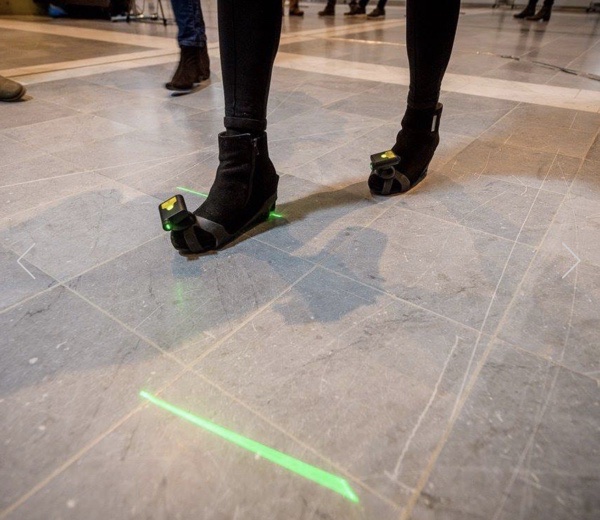
According to the manufacturer, "Path Finder is a shoe attachment that provides visual laser cues for patients suffering from Freezing of Gait (FoG), a symptom of Parkinson’s (PD) and other neurological disorders, severely impacting gait and quality of life. These visual laser cues are in the form of horizontal lines, prompting the individual to take steady steps with both feet, one after another. This hands-free device is meant for individuals with unsteady gait, and can be used to gain confidence, regain mobility, prevent falling and improve quality of life."
It uses a green Class 2 laser, meaning the light is considered safe for normal operation. According to LaserSafetyFacts.com's page on Class 2 lasers, "It normally would not harm an eye unless a person deliberately stared into the beam."
The idea for Path Finder came to inventor Lise Pape in 2014, after watching her father struggle with Parkinson's. She became aware that visual cues such as lighted canes had been used with some success to help trigger a normal step response. She started work on a prototype in 2014, and the product came to market in 2017.
It has won more than fifteen awards, including the AXA Health Tech and You Award in the UK in 2016 and Vodafone TechStarter in the UK in 2019.
Story from Digital Health with information from the Path Finder website and news blog.
Canada: New pilot laser glare protection eyewear using holographic optical filter
The most common laser color reported by pilots is green, representing approximately 90% of reports made to the U.S. Federal Aviation Administration. As of 2019, the most common green is 532 nanometers, produced by low-cost, high-power diode-pumped solid state laser pointers and handhelds.
metaAIR's first offering protects against 532nm green laser light, using holographic "nano-pattern layers". These can precisely reflect 532nm light while allowing high visibility for other wavelengths — crucial for pilots' night vision and for correct color discrimination of cockpit instruments and airport lighting. MTI adds an additional layer to improve color balance and discrimination, as well.
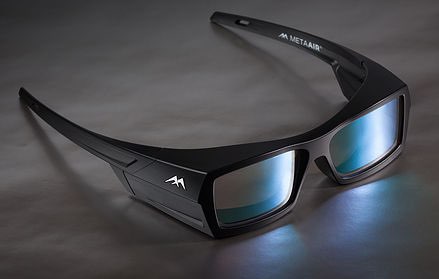
The eyewear is said to have an Optical Density between 2 and 5, meaning that it will attenuate the amount of 532nm light reaching eyes by 100 to 100,000 times. The primary goal is to reduce or eliminate visual interference effects such as flashblindness, glare and distraction. A secondary benefit is that attenuating 532nm light will also help protect against any potential eye injury. (Note that as of February 2019, no documented pilot eye injuries have occurred according to the U.S. FAA, U.K. CAA and Transport Canada after almost 75,000 reports of aircraft illumination. Laser/aviation safety experts consider visual interference to be a more significant safety concern than pilot eye injuries.)
The frame is wider at top, sides and bottom, to block light coming from directions other than the front.
MTI originally developed the holographic laser-reflecting technology for use in windscreens. The goal was to protect pilots without the need for eyewear. However, windscreen modifications require a slow, multi-year process of obtaining governmental and airline approval. In addition, the cost to modify windscreens is much higher than the cost of one or two pairs of eyewear. So eyewear was a natural choice for the first commercially available laser protection product from MTI. According to its metaAIR website, the company may also produce glare shields using the same technology.
MTI is taking pre-orders for its eyewear, distributed by Satair, which will be available "spring 2019."
From MTI's metaAIR website, accessed February 25 2019.
Canada: Study first to show prevalence of laser use, injuries among general public
It showed that 48 percent of Canadians over the age of 12 either used or were exposed to lasers, annually.
Of those who reported using a laser product, 1.1% reported discomfort or injury.
[LaserPointerSafety.com analysis: Based on 2016 Canadian census data, there were 29,312,165 Canadians age 15 or older — data was not available on age 12+. If 48% of these 29 million Canadians used or were exposed to lasers, that would be just over 14 million people. If 1.1% of them experienced discomfort or injury, that would be about 155,000 Canadians with laser discomfort or injury.]
Returning to the Statistics Canada study, of the discomfort/injury cases:
- 41% were for skin injuries "such as rash, itch or pain," while 59% were for eye injuries "such as itchiness, pain, visible floating objects, blurred vision, burn, flash blindness, excessive watering or loss of sight."
- In 64% of cases, the discomfort or injury lasted less than two days; in 34%, it lasted more than two days.
- The discomfort/injury was caused by the person's own use of the laser in 25% of cases, and by someone else's use in 75% of cases.
- 39% of the discomfort/injury cases were caused by cosmetic treatments, 26% were caused due to laser pointers, and 34% were caused by "other" which included surveying tools, entertainment lasers, materials processing, and scanners.
The study analyzed published eye injury case reports since 1999, and concluded:
"…the majority involved the misuse of a handheld battery-operated laser product by an adult or a child. Most of these injuries were the result of irresponsible use or deliberate staring at a laser by a child, or the result of the inappropriate use of a high-powered laser device (Class 3B or 4) in an 'uncontrolled environment'....In the cases reported in 2014 that included long-term follow-up injury reporting, about one-half of the ocular injuries resolved within one to two weeks, with the other 50% of patients sustaining longer-term visual impairments."
Click to read more...
Canada: Satair, Metamaterials sign anti-laser glare protection distribution deal
Customers will include commercial and military pilots, both fixed-wing and rotary, in markets including commercial aviation, business aviation, search and rescue, police, medevac and military.
Satair is a part of the Airbus Customer Services unit. In 2014 Airbus brought Nova Scotia-based MTI into an innovation start-up program, working to commercialize aircraft windscreen film to protect pilots from laser glare and flashblindness. In June 2017 Satair and MTI signed a memorandum of understanding focused on the civil aviation market.
According to MTI, "Detailed market research and discussions with potential customers since then has confirmed that the overwhelming preference is for this innovative new product to be introduced to the market through individual eyewear and visor products which incorporate MTI’s laser glare protection technology."
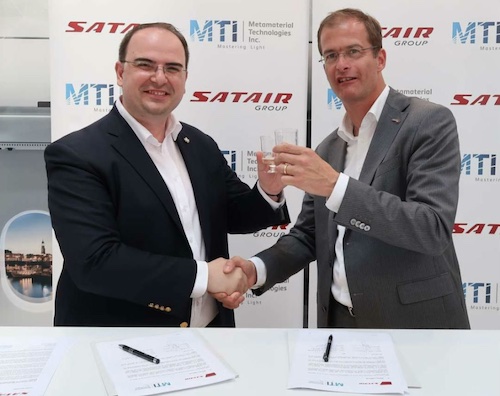
MTI's George Palikaras, founder and CEO (l), and Satair CEO Bart Reijnen (r) sign a distribution agreement at the October 2018 MRO Europe trade show for maintenance, repair and overhaul operations.
The October 2018 agreement widens the market and covers "eyewear and visor products that are developed or manufactured by MTI. These include, without limitation, all sub-components, sub-assemblies, piece parts, software and hardware."
MTI says their technology "is superior to other products currently on the market due to a unique and patented dielectric (non-metallic) optical metamaterial filter, which has been scientifically engineered to ensure that the pilots’ vision and interpretation of the surrounding environment is not disturbed during critical phases of flight."
From an October 17 2018 Metamaterial Technologies Inc. press release
UPDATED: In a February 19 2019 press release, Satair's customer solutions director says initial product applications will appear in the first quarter of 2019. He also said "The technology is highly scalable so it can be customised for a wide variety of platforms and other applications. In commercial aviation the green laser poses the biggest threat because the human eye is more susceptible to the green wavelength. For military markets the red laser may be the largest threat. The advantage of the MTI product compared to other products in the market is that it can be customised to the wavelengths the customer wants to be protected against. As we have exclusive distribution rights across civil aviation, military and defence, we are open to do business with leading OEMs of products such as night vision goggles, head-up displays, helicopter and fighter pilot helmets and aircraft flight deck visors. Other products in the market do not have the same quality, the same level of protection and colour balance that we have.
Thanks to Peter Smith and Leon McLin for bringing the February 2019 press release to our attention.
Canada: Restrictions on high-powered handheld lasers in three cities
Persons are banned from possessing such lasers outside of their home, without a legitimate purpose such as work, school, education or astronomy.
Police can question anyone with a laser in one of the prohibited zones if they had a reasonable reason to search them. Examples given included if a member of the public contacted police with a specific description of a person they saw holding a laser, or if police themselves saw the person holding a laser.
Any person with a battery-operated, handheld laser in a prohibited zone 1) outside of a private dwelling and 2) without a legitimate purpose could be fined immediately and “on the spot” up to CDN $5,000. A corporation violating the law would be fined up to CDN $25,000. The fines are in addition to any criminal prosecution; intentionally aiming a laser at an aircraft could result in five years in prison and/or up to CDN $100,000 in fines.
According to Transport Canada, “You don’t need to carry any documentation, but you should be prepared to demonstrate to the officer why you’re in possession of a hand-held laser. Law enforcement will be trained to know when and where people may possess a laser. They will exercise their discretion and judgement when determining whether or not to issue a fine.”
Transport Canada has a webpage with details of the laser prohibitions, a question-and-answer page about the new laser safety measure, and an online forum “Let’s Talk - Lasers” seeking feedback on laser safety issues. The “Let’s Talk - Lasers” consultation closes for comments on August 27 2018.
They also have an online interactive map detailing the prohibited zones. Here are two examples of map output:

Laser-prohibited zones in the entire country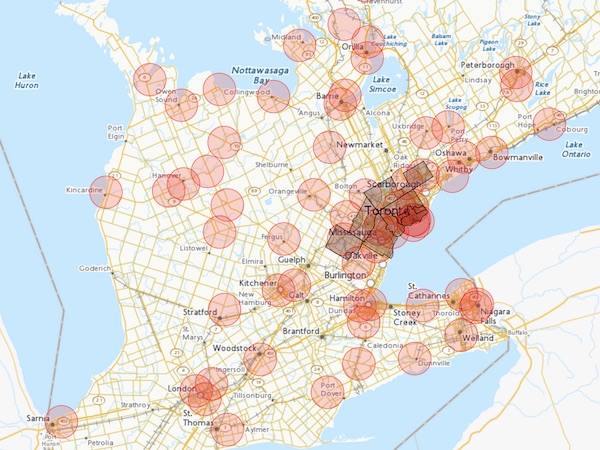
Closeup of laser-prohibited zones in the Toronto area
The three metro areas of Montréal, Toronto and Vancouver were included since, according to Transport Canada, “The majority of reported laser attacks have occurred in these regions. Transport Canada will continue to monitor the number and location of reported incidents and may adjust the included municipalities as warranted.”
The agency discussed how the fines were determined, and how law enforcement will decide on the exact fine amount: “These fines, called administrative monetary penalties, come from the Aeronautics Act and the Canadian Aviation Regulations. Law enforcement uses discretion on how much to fine an individual. The amount may depend on previous infractions and circumstances surrounding this infraction.”
When concluding his announcement, Garneau stated “we have the tools that law enforcement agencies need, including Transport Canada inspectors and police forces, in order to put an end to these careless and reckless actions — actions that could have tragic results.”
From the Canadian Press, the CBC, iPolitics, a video of Marc Garneau’s announcement on GlobalNews.ca, and the Transport Canada informational webpage and Q&A webpage.
For much more information and commentary from LaserPointerSafety.com:
Canada: CDN $3M loan to MTI to manufacture laser eye protection glasses
The company’s metaAIR eyewear uses holographic technology to reflect unwanted wavelengths of light while passing others. According to MTI founder and CEO George Palikaras, the clear glasses do not affect vision like current solutions that can be too dark or affect colors.
“What is innovative in our eyewear is that it does not affect the pilot’s vision. So when you put them on you can still see that green is green, blue is blue and red is red,” Palikaras said at a May 4 2018 press conference. In the photo below, Palikaras is wearing the glasses, which reflect some wavelengths but otherwise appear clear to the wearer.
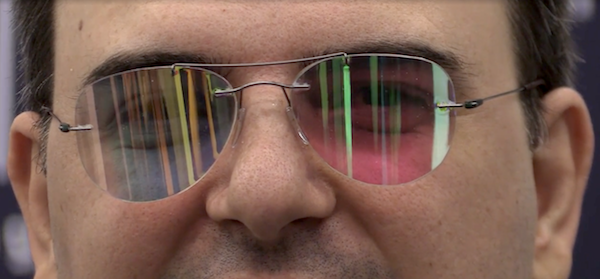
The glasses’ ability to reflect unwanted wavelengths were demonstrated by blocking 99.9% of the green light from a handheld Class 4 (> 500 milliwatts) 532 nanometer laser:
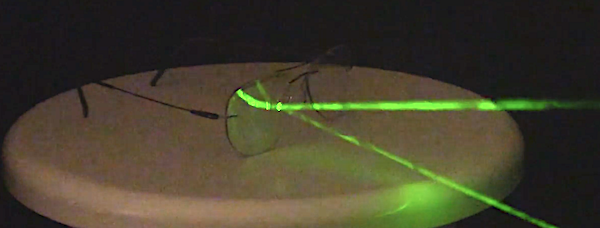
Palikaras said that besides pilots, MTI has had inquiries from the navy and from train operators. He cited incidents involving trains in Germany and Switzerland.
He said the glasses will be sold through MTI’s partner companies and directly to industry buyers.
As of May 2018, MTI has 27 employees, and is looking to hire 15 new full-time employees in production, marketing, research and development. MTI’s holographic technology is also used in developing aircraft windscreens with laser glare protection.
The $3M loan was provided by the Atlantic Canadian Opportunities Agency.
From the Chronicle Herald
Canada: Looking at "all possible options" to fight laser incidents; perhaps a ban and mandatory labels
The statement came after six laser incidents over two days earlier in the month, at Montreal’s Trudeau Airport. Garneau said these made him “very, very mad.”
A Transport official said the options include a ban on importation of powerful lasers, mandatory warning labels, and stronger penalties for those who are caught.
Garneau noted that it is hard to catch a laser perpetrator, making prosecutions “few and far between”. He believes that some people are not aware of the bright-light danger of laser light, but that others “know darn well what they’re doing” and are trying to “provoke something.”
Transport Canada currently has a program called “Not-a-Bright-Idea,” trying to educate the general public about the risks and legal consequences of aiming lasers at aircraft. Since implementing the program in May 2016, laser incident numbers have dropped. There were 590 reported incidents in 2015, 527 in 2016, and 379 in 2017.
Garneau said that despite the 28 percent drop, Transport Canada must do more, and that is why they are exploring other options.
From 660 News and AVweb
Note: In response to a LaserPointerSafety.com request, an email address for interested persons was provided: “Transport Canada is exploring options to reduce laser strikes. Canadians and industry members can provide information to the Civil Aviation Communications Centre by emailing: services@tc.gc.ca”
Canada: Students developing laser scarecrow to keep geese from crops
The group’s research found that green lasers, even at low power levels, scare geese at night when they are roosting in fields, eating the green shoots of crops such as wheat and barley. They can do “significant damage,” Rashleigh said.
There is a solution during the daytime involving noise from pyrotechnics, but this can’t be used at night in a residential area.
For nighttime geese deterrence, the students looked at other options and concluded that using lasers was the best way to solve the problem. They developed a device placed about 12-15 feet off the ground, installed in the center of the field. It moves the laser across an area, throughout the night. So far, it appears to be “fairly effective.” Response has been “quite positive” from other farmers.
Rashleigh told CBC News that “safety is a huge concern.” The laser only shines where it is intended, in the field. The beam is less powerful than most handheld laser pointers; a person would have to stare into the beams for “about 8 seconds” to have any risk of damage. To protect aircraft, the device can detect if it is being pointed above the horizon, and can shut itself off.
From CBC News, via Forbes
Canada: Transport Canada warning of laser dangers via social media
The campaign began with a press conference where Marc Garneau, Minister of Transport and Tony Cusimano, Superintendent of York Regional Police spoke about the hazards.
Garneau said, "Pointing a laser at an aircraft is not only a reckless act that puts people at unnecessary risk, it’s simply not a bright idea. As Minister of Transport, I take this type of behaviour seriously because Canadians and their families deserve to feel safe while flying. We want people to know there are serious consequences, including $100,000 in fines and up to five years in prison. Transport Canada and law enforcement across the country are working together to ensure offenders face the fullest force of the law.”
Transport Canada has set up a website at www.tc.gc.ca/NotABrightIdea. It includes a catchy animated video, “Dumb Ways to Blind” aimed at millennials, plus three other more conventional videos on the topic.
According to the website, “[i]n 2015, there were almost 600 reported incidents.” This was an increase over the 502 incidents reported in 2014.
Transport Canada urges those interested to use the hashtag #NotABrightIdea. On Twitter, since January 1 2016 there have been about 40 posts with this hashtag; 33 of them about lasers and 7 about other topics that are “not a bright idea.”
From a news release issued by Transport Canada
Canada: 663 laser/aircraft incidents in 2015 based on newspaper analysis of CADORS data
Here is the CADORS data:
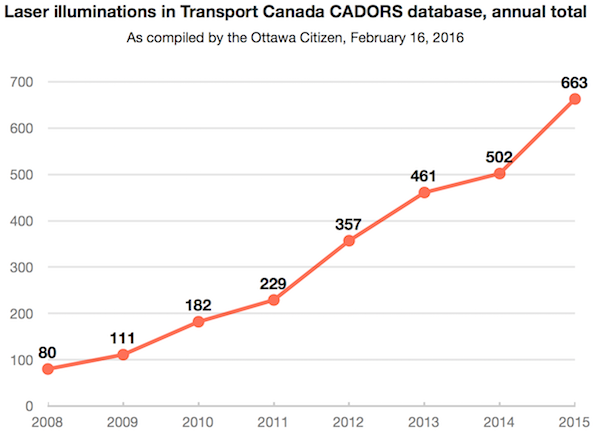
Compare this with the number of illuminations in the United States over the same period:
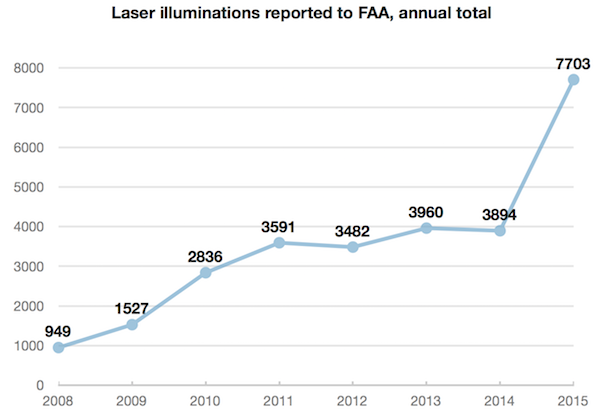
Canada’s data roughly tracks the U.S. data. Here are the two charts above, superimposed, with the CADORS numbers multiplied 11.7 times. The slope of the lines are similar for all but 2013/2014, and the endpoints are remarkably close.
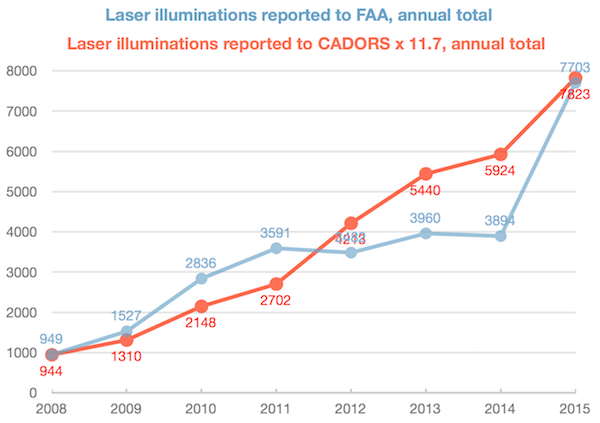
From an analysis by Andrew Duffy in the Ottawa Citizen. Note that a few days earlier, CBC News stated that there were 590 laser/aircraft incidents in 2015. There is no indication as to reasons for the discrepancy.
Canada: 590 laser/aircraft incidents in 2015; pilot group wants handheld lasers classed as weapons
The head of the Air Canada Pilots Association said that the figures show that education is not working, and handheld lasers should be designated as prohibited weapons.
From CBC News. Note that a few days later, the Ottawa Citizen did an analysis of Transport Canada’s database which shows different figures: 663 laser incidents in 2015, which is up 32% from the 2014 total of 502.
Canada: Government launches safety campaign to warn against pointing lasers at aircraft
Helping Canadians better understand the dangers lasers pose to aircraft
The Honourable Alice Wong, Minister of State (Seniors), on behalf of the Honourable Lisa Raitt, Minister of Transport, today launched the Government of Canada’s safety awareness campaign for lasers. The national campaign will help Canadians better understand why pointing a laser at aircraft is not a bright idea.
The first phase of the campaign, unveiled today in collaboration with the Vancouver International Airport, the RCMP, and NAV CANADA, provides the public with an easy to follow infographic, which clarifies the dangers and consequences of pointing lasers into airspace and how incidents can be reported. This summer, the second phase of the campaign will include digital advertising, awareness videos and a direct mail campaign near three major airports.
Transport Canada has also launched tc.gc.ca/NotABrightIdea, which provides Canadians with the information they need to better understand the dangers of pointing a laser at an aircraft.
Transport Canada is working closely with police, other government departments, and the aviation industry to protect pilots, passengers, and people on the ground. If you see a laser pointed at an aircraft, report it to your local police.
Quick Facts
- The number of lasers pointed at aircraft is rising in Canada. In 2014, there were 502 reported incidents – a 43% increase since 2012.
- Aiming a laser at an aircraft is a federal offence. If convicted under the Aeronautics Act, an offender could face up to $100,000 in fines, 5 years in prison, or both.
- Canadians can join the conversation and learn more by using the #NotABrightIdea hashtag on Twitter.
Canada: 502 laser/aircraft incidents in 2014
From the Transport Canada webpage Aiming a laser at an aircraft? Not a Bright Idea.
Canada: 61 pilots studied after laser exposure; no problems found
Examinations were done within three days of the strikes: “Early Treatment Diabetic Retinopathy Study visual acuity, colour vision, visual fields, intraocular pressure, slit-lamp examination, dilated fundus examination, colour fundus photographs, and ocular coherence tomography.”
The paper concluded, “Our study revealed that laser strikes on aircraft did not result in permanent visual functional or structural deficits. However, laser strikes cause immediate visual effects, including glare, flash blindness, and ocular irritation that can interfere with a pilot’s visual function.”
From the Canadian Journal of Ophthalmology, December 2015, Volume 50, Issue 6, pages 429-432. For the full abstract of the study, click the “Read More…” link.
Click to read more...
Canada: Saskatoon officials warn about laser pointer hazards
One pilot said that lasers have been pointed at him “at least 10 times in the past 3 years.”
A CJME news story notes that “pointing a laser at planes could land those responsible in hot water under the Canadian Aviation Regulation Act. Potential penalties range from fines of $3,000 to multi-year probation sentences and incarceration. Charges could also include mischief, assault with a weapon and assault of a police officer.”
From CJME.com and 620CKRM.com
Canada: UPDATED - Airbus to test windscreen anti-laser film
Lamda Guard’s “metaAir” film uses metamaterials, also called nano-composites, to reflect one or more laser colors without interfering with normal visibility. According to the company, the film can protect from beam angles up to +/- 50 degrees away from head-on. This has benefits when protecting cockpits against laser strikes, which can come from any angle.
It can be adhesively applied to glass or clear plastic; applications include eyewear, protective goggles and windscreens. Lamda Guard says that the Airbus tests on windscreens will mark the first time an optical metamaterial nano-composite has been applied on a large-scale surface.
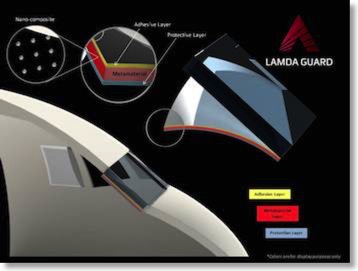
General schematic of metaAir film. Click for larger image.
The metaAir film can be engineered either to absorb or reflect the desired wavelength(s). For aircraft application, the reflection approach is being used in order to block undesired light wavelengths from entering the cockpit. The reflection bandwidth is currently in the 15-20 nanometer range.
For the most common type of green laser pointer -- responsible for 93% of FAA reported incidents in 2013 -- with a wavelength of 532 nm, the film would block light from about 522 to 542 nm. Additional wavelength blocking can be added as well, such as the 445 nm blue used in powerful handheld lasers such as the Wicked Lasers S3 Arctic that has up to 2 watts (2000 milliwatts) output.
Two key advantages of blocking laser light at the windscreen are that pilots do not have to carry or use laser protective eyewear, and there is absolutely no interference with the visibility of aircraft instruments. In preliminary tests, the anti-laser film had a narrow enough bandwidth that it did not interfere with airport lights seen outside a cockpit.
Because of ultraviolet degradation to the adhesive layer that adheres the optical metamaterial to the windscreen, the film would need to be replaced after about 5,000 flight hours. This translates into overnight replacement roughly once every three years. The optical metamaterial itself would not have a flight hour restriction.
In addition to piloted commercial aircraft windscreens, Airbus will also be investigating related applications such as piloted military windscreens, UAV camera protection, and sensor protection for satellites and airborne platforms.
Canada: After 461 lasings in 2013, pilots want stricter penalties plus government controls on lasers
In addition, Capt. Craig Blandford said “We’d (also) like to see a control put on them, some kinds of permits or access to these things that’s somehow controlled. I’m not sure to go so far as to say we want them on a prohibited weapons list, but that’s one of the things that we’re pursuing in order to get stricter on control.”
In 2013, there were 461 laser/aircraft incidents reported to Transport Canada, as compared with 357 in 2012. As of February 12, there have been 44 incidents in Canada during 2014.
From the Ottawa Citizen. The story includes additional details on Canada statistics and the pilots’ proposals.
Canada: Regina has 12 laser pointer incidents thus far in 2013
This compares with five laser incidents during 2012, and one during 2011.
The officials reminded the public that lasing an aircraft is illegal.
From CTV News and OHS Canada
Canada: Laser strikes up significantly in Edmonton
A police pilot spokesperson said laser users are not reading the packaging which clearly states not to aim at aircraft. After being caught, "There's been a lot of apologies, a lot of regret, some people not realizing the consequences of what they were doing, and then there's been the far opposite -- I can't believe this is happening, this is ludicrous, this isn't serious, it's just a laser pointer."
The pilot also said that a ban is not the answer: "If it's used properly, it's harmless. It's hard to ban something like that, the sale of it completely if 95% of the general public are using it properly."
He noted that not just police aircraft are being lased. Commercial and private aircraft also are at risk.
Edmonton police helicopter pilots are equipped with safety glasses for use during laser illuminations. They have two pair, one to attenuate red laser light and one to attenuate green laser light.
For details on the two most recent Edmonton incidents, on September 6 and 7 2012, see this LaserPointerSafety.com story.
From the Edmonton Journal and Edmonton Sun. Thanks to Keith Murland for bringing this to our attention.
Canada: RCMP purchases anti-laser glasses
From Vertical magazine
Click to read more...
Canada: Health Canada again warns about hazards of pointers, handheld lasers
The agency states that battery-powered pointers and handhelds “manufactured, advertised, sold, imported or leased should be limited to … Class 3R” which is less than 5 mW visible output. It is unclear whether “should” is advisory or is a regulatory requirement.
The document focuses on eye, skin and fire hazards of lasers and does not discuss the problem of visual interference with pilots’ or drivers’ vision while operating vehicles.
From Newswire. The 2012 Health Canada press release is below (after the Read More… link). The July 2011 press release is here.
Click to read more...
Canada: Laser statistics for 2010, 2011 and Q1 2012
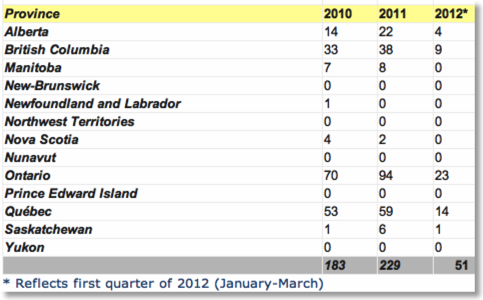
According to the Toronto Star, from January 1 to late May 2012 there have been 36 laser incidents at Pearson International and other Toronto-area airports, and 100 incidents nationwide. (This is probably based on their own analysis of the CADORS incident database since the Transport Canada chart above only went through the first quarter of 2012.)
WestJet has arranged for a Calgary-based ophthalmologist to examine pilots’ eyes after laser incidents. A spokesperson said “We want to have an individual identified in every major city so we can send that (pilot) right away to be tested.”
Canada lags other countries in aggressively prosecuting offenders, according to the chair of the flight safety division of the Air Canada Pilots Association: “The judicial system should apply the law to its maximum extent rather than soft-shoeing around the issue.” At the federal level, aiming a “directed bright light” at an aircraft is illegal under the Aeronautics Act. The maximum penalties are a prison term of five years and a fine of $100,000.
From the Toronto Star; chart courtesy Transport Canada
UPDATE, May 30 2012: At LaserPointerSafety.com’s request, Transport Canada analyzed first quarter incident statistics for the past three years. They found 29 incidents in Q1 2010, 27 incidents in Q1 2011, and 53 incidents in Q1 2012. (Note that they found two additional Q1 2012 incidents which were not included in the province-by-province breakdown above.) A Transport Canada spokesperson speculated that reasons for increased incidents in general may include increased awareness and reporting by pilots, and “copycat” actions by persons who would not think to aim a laser at aircraft until they hear news reports of incidents.
Canada: Calgary astronomers agree with $5000 fine
Saulnier told police he had the pointer because he was an amateur astronomer. The Calgary representatives of the RASC said Saulnier was “not an RASC member, nor [was he] known to us.” They pointed out that responsible amateur astronomers would use lasers only on astronomical targets on clear nights when others are present: “There is no legitimate solo use of pointing a laser pointer into the sky that we can think of.”
From the Calgary Herald
Canada: Health Canada warns about dangers of pointers, handhelds
They caution that laser pointers should be limited to IEC Class 3R (less than 5 milliwatts for visible beams). Health Canada says that higher powered Class 3B and 4 lasers “should not be used as laser pointers or in any other application unless operated by individuals who have been professionally trained in laser safety.”
The full text of the press release, including instructions on how to report suspected laser injuries, is available by clicking the “read more” link below.
From MarketwireClick to read more...
Canada: Pilots want lasing to be a criminal offense
Currently, violations of the Aeronautics Act can lead to fines of up to $100,000 and up to five years in prison. Despite this, laser illuminations continue to occur.
In 2010, there were 182 reported laser pointing incidents. Ontario had the highest number, 69, followed by Quebec with 53 incidents. Transport Canada and the ACPA said this was due to increased reporting, copycat laser use, and the increased availability of laser pens and pointers.
“This is just like shooting a gun at an airplane around [an] airport,” according to Nick Stoss, formerly with the Transportation Safety Board.
From Global Winnipeg
Canada: Man gets lower fine, in part because pilot did not lose control
Provincial Judge Paul Sully said the August 19 2009 incident was "not as serious” as the prosecutor described, since the pilot did not lose control, but instead was "momentarily blinded from viewing his instruments [and] was able to complete his orbits.” In addition, the judge noted that the pilot was familiar with the dangers of laser light.
Judge Sully also rejected the prosecution’s notion that the man should have culpability: “The offender had a momentary loss of common sense which resulted from his failure to recognize the high standard of care needed when handling a laser.”Click to read more...
Canada: 2010 laser/aircraft incidents almost double 2009
Transport Canada also released figures on incidents in Alberta, after an Aug. 16 arrest in Calgary. So far in 2010, there have been 11 reports of laser beams aimed at or hitting aircraft, compared with nine in all of 2009.
From the Calgary Herald
Canada: List of many Canadian incidents
- A Cessna pilot flying over downtown Vancouver on May 25 2009, who had "flash blindness for a few seconds"
- More than two dozen reports of lasers being directed at airplanes in British Columbia since 2000.
- About 100 incidents of laser beams pointed at aircraft across Canada, since 2005.
- A Cessna pilot in June 2008 who "experienced slight vision impairment, and for safety reasons requested a wide left-hand 270-degree turn ... for brightness recovery and a stabilized approach".
- A helicopter co-pilot in November 2007 who looked at a laser and "was experiencing sun spots [sic] in her vision, which continued for the remainder of the flight."
- At least three incidents, two in June and one in November 2008, where Royal Canadian Mounted Police pilots were targeted.
- In July 2008, a Calgary man was fined $1000 after pleading guilty to shining a laser at an Air Canada flight.
Culbert's story also lists the first attack LaserPointerSafety.com is aware of on a blimp: "A green light was pointed into the cockpit of a blimp over Victoria's [B.C.] shoreline in October 2005. [CADORS reported that] 'several laser attempts were made and the pilot said he was affected twice. Quite aggressive attempts were made by the person using the laser light according to the pilot.' "
Canada: Video report on "stupid hobby" of shining laser lights at planes
Also, there is a related print story from the CBC website. It does not have the same voiceover as the video report, but does go over similar points, including this one:
"We don't want this to become a bigger hobby — a bigger, stupid hobby," said Serge Beaulieu, spokesman for the Air Canada Pilots Association.
Canada: Pilots call for better labeling; tougher penalties
According to Transport Canada, there have already been 56 occurrences this year [2008] compared with 21 in 2007. The department has recorded a total of 83 since 2005.
"The increase in the number of laser events that are occurring in Canada and around the world are alarming to us," said Capt. Barry Wiszniowski of the Air Canada Pilots Association. "The laser events that are occurring are probably one of the greatest safety concerns that we have right now as a profession."
Wiszniowski said the industry is calling on laser manufacturers to develop labeling that will contain warnings similar to those on tobacco products.
He is also encouraging the courts to issue stiffer penalties to offenders.
Many more details at Metronews
Canada: Number of pilots blinded by laser pointers increases
As of October 17 this year, Transport Canada had received 46 reports of incidents involving "directed bright lights" being shone at a civilian airplane's cockpit from the ground, says Jean Riverin, a spokesman for the national regulator. This compares with 21 reports for all of 2007, and only three each for 2006 and 2005. When Transport Canada receives a complaint, adds Riverin, "we notify the RCMP or local police, who coordinates the investigation."
It is an offense under section 74.1 of the federal Aeronautics Act to "engage in any behaviour that endangers the safety or security of an aircraft in flight." A violation of the act can lead to a maximum penalty of $100,000 or five years imprisonment following a conviction, or to $25,000 or 18 months imprisonment following a summary conviction.
Click to read more...